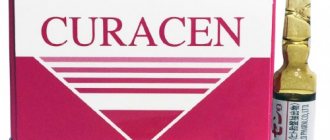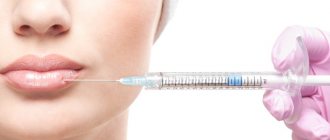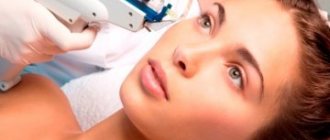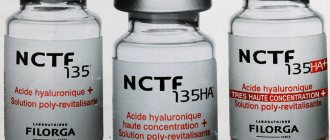The essence of plasma lifting
The effect of plasma isolated from the patient’s blood before the procedure on skin cells is the basis of the plasma lifting technique. Plasma is injected into a selected area of skin using microneedles or a syringe with replaceable needles. This technology is used not only for skin aging and the appearance of wrinkles, but also for baldness and weak hair - plasma injections can also be given into the scalp.
Plasmolifting has several serious advantages over other injection rejuvenation techniques. The main one is relative safety. Plasma for injection is always compatible with the patient's body because it is obtained from his own blood.
Contraindications
Despite its safety and effectiveness, plasma lifting is not suitable for everyone. In case of diseases of the circulatory system, exacerbation of autoimmune diseases, pregnancy, breastfeeding, it is better to postpone plasma injections until later or choose another rejuvenating procedure.
Plasmolifting. What is this?
A cosmetic injection procedure in which the patient’s plasma is injected under the skin. This is an effective way of facial rejuvenation, which allows you to naturally start the processes of regeneration and metabolism in tissues.
Plasma for administration is taken from the patient's venous blood. After collecting the biological material, it is placed in a centrifuge, where the plasma is separated from the blood. It contains platelets, which influence the rapid healing of the skin and activate the rejuvenation effect.
After plasma lifting injections, you can get rid of both obvious signs of age-related aging and excessive dryness of the skin, pigmentation and even acne. The effect after the sessions lasts for 2-3 years, and the procedure itself does not require surgical intervention. The absence of side effects and real visible results have made plasma lifting one of the most popular procedures of the last 10 years in all cosmetology clinics.
The essence of biorevitalization
Another injection procedure that helps restore youth to the face is biorevitalization. Hyaluronic acid is the main component of biorevitalization preparations; thanks to it, the skin becomes more hydrated and elastic, and recovers faster.
A little about hyaluronic acid
Hyaluronic acid keeps the skin hydrated because it retains moisture in its cells and creates an imperceptible protective film on the surface. Hyaluronic acid in the human body is found not only in the skin, but also in all other parts of it - in joints, bones, and nerve tissues. For the first time it was discovered in the eye, or rather in its vitreous body.
As a person ages, hyaluronic acid is removed from the body more actively, which leads to the appearance of wrinkles and sagging skin. 25 years is still a very young age, but by this time the formation of the element in the body slows down.
Contraindications
During a biorevitalization session, not pure hyaluronic acid is injected into the skin, but a drug based on it. Some components of this drug may cause an allergic reaction. Despite the fact that the likelihood of such an outcome is low, performing biorevitalization on people allergic to the components of hyauronate is unacceptable. Those who suffer from cancer and autoimmune diseases, pregnant and lactating women will also have to refuse biorevitalization. If there is damage to the facial skin, the procedure is also not performed.
Mesotherapy and plasma lifting
Make an appointment Has your skin become dry, dull and flabby?
Are there signs of aging? Sun exposure, taking antibiotics, metabolic disorders, and smoking deprive the skin of the required amount of moisture, which makes it very dry, irritated and flaky.
All this can lead to the formation of wrinkles and decreased skin turgor. To prevent this from happening, it is recommended to carry out a course of mesotherapy or plasma lifting.
Which technique is better?
Both rejuvenation technologies are quite safe and effective; it is not easy to choose the most suitable one. Let's compare plasma lifting and biorevitalization according to eight main criteria.
Simplicity
Both plasma lifting and biorevitalization involve the introduction of a drug into the skin, so they are not too different from each other in ease of implementation. A small obstacle before rejuvenation with the help of plasma is a blood test for biochemistry. The analysis is necessary to check the condition of the blood and make sure there are no hidden contraindications to plasma lifting. Biorevitalization turns out to be even simpler than plasma therapy, therefore you can influence the skin with hyaluronic acid not only with injections, but also using a laser. The ability to refuse injections will allow people who are afraid of syringes and needles to make an appointment with a cosmetologist for a rejuvenation procedure without any doubt.
Price
The equipment for plasma lifting is more specific, and the procedure itself is more complicated due to the fact that it requires isolating plasma from the blood immediately before the session. For the greatest effect, plasma lifting sessions may require more. For these three reasons, a course of plasma lifting turns out to be more expensive than a course of biorevitalization.
Session duration
The time required for procedures varies slightly. A facial skin plasmolifting session usually takes only 30 minutes, while a cosmetologist performs hyaluronic acid injections for about an hour.
Efficiency
Both biorevitalization and plasmolifting are quite effective procedures, but they differ in how quickly the results appear and how long the youthful appearance of the skin lasts.
Hyaluronic acid injections have an almost immediate effect. On the same day of the procedure, patients notice that their complexion has become more even and their skin has begun to smooth out. You will have to wait about two weeks for the effect of plasma lifting. To ensure a guaranteed result, you not only need to attend injection sessions on time and follow care recommendations, but also eat a balanced diet and drink enough water every day.
Now it may seem that biorevitalization is much more effective than plasma lifting, but the effect of plasma on the skin has an advantage - the youth and elasticity of the skin is preserved for one to two years. Biorevitalization procedures will have to be repeated several times a year to maintain the effect.
Suitable age
Some skin diseases that actively manifest themselves in adolescence can be treated with plasma lifting. Plasma injections, for example, help get rid of acne and scars. After 55 years, plasma therapy is contraindicated, since this procedure strains the immune system. Chronic diseases, which many people have in adulthood, can worsen.
Injections of hyaluronic acid are suitable for patients over 25 years of age, because until this age the body independently produces enough of this substance. Unlike plasmolifting, biorevitalization does not cause health problems if the patient is over fifty years old. Moreover, the intake of hyaluronic acid into the body can improve its well-being.
Disease Control
The most serious obstacle to biorevitalization is psoriasis. In the presence of such a diagnosis, the introduction of hyaluronate into the skin is unacceptable. Plasmolifting is sometimes used specifically to make the symptoms of psoriasis less pronounced - it is not yet possible to completely cure this disease.
Hyaluronic acid protects the skin from inflammation, so it rarely appears on the face after biorevitalization. A plasma lifting session, on the contrary, can cause inflammation in the treated area of skin.
Allergenicity
For the greatest safety, when collecting blood, special tubes coated with gel on the inside are used. This gel prevents blood components from mixing after centrifugation.
Most people do not know the name of each substance they are allergic to, so they do not expect an allergic reaction after injecting a hyaluronic acid product into their skin. Such problems do not arise so often after biorevitalization, but the likelihood of their occurrence is slightly higher than after the plasma lifting procedure.
Skin condition after the procedure
During a plasma lifting or biorevitalization session, the cosmetologist injects the drug with a very thin puncture, so you should not be afraid of temporary redness of the skin immediately after the procedure. If the skin remains red for a long time, this may indicate inflammation or an allergic reaction. In this case, you need to consult a doctor.
The appearance of small swellings in the places where punctures were made is a normal consequence of biorevitalization. The bumps on the skin do not last long; they disappear on average two days after the session. Some patients experience hyperemia, overflow of blood vessels with blood. Symptoms of hyperemia - redness, swelling. Possible increase in temperature. All these unpleasant phenomena soon disappear.
Biorevitalization or plasmolifting: Which is better?
Biorevitalization and plasmolifting are two injection cosmetic procedures that are aimed at rejuvenating facial skin and combating age-related changes.
These methods are used in aesthetic cosmetology clinics to eliminate deep wrinkles on the face in the area of the eyelids, forehead and nasolabial folds, as well as to combat low turgor and dry skin. Biorevitalization together with plasmolifting can also be performed as an additional procedure for accelerated recovery after chemical peeling or laser rejuvenation. These two methods are similar to each other and can even complement each other to achieve better results. But what are the differences between them? What is better to choose: biorevitalization or plasma lifting? Let's take a closer look at each of the cosmetic facial procedures so that you can make your choice.
Simultaneous exposure
It is unacceptable to conduct plasma lifting and biorevitalization sessions one after another. A competent combination of these techniques gives a high-quality result, because the two substances improve the absorption of each other in the body.
The combination of rejuvenation technologies occurs in two stages. First, three to four plasma lifting procedures are performed at intervals of a week, the course takes about a month. Another week is spent on skin restoration, after which the patient attends a contouring session using hyaluronic acid.
Skin care courses can be supplemented with mesotherapy procedures. This technology is also based on injections, but it is not natural components that are injected into the skin, but chemical cocktails. In some cases, mesotherapy causes allergic reactions, so consult your doctor before you begin such treatments.
How to make a choice
Both procedures are very effective in preventing aging and improving the condition and appearance of the skin.
They have a much more noticeable visual effect than the use of masks, creams or other external care products, the active components of which penetrate deep into the skin only to a small extent. Among the general recommendations for selection, the following points can be highlighted. Mesotherapy is recommended from the age of 18, while biorevitalization is indicated for girls after 25–30 years, when the body’s production of its own hyaluronic acid begins to gradually decrease. The introduction of hyaluronic acid preparations is much more effective for the prevention of photoaging and skin restoration after prolonged exposure to the sun.
Mesotherapy, due to the use of a wide range of components with different biological effects and the possibility of individual selection of compositions in accordance with existing cosmetic deficiencies, can solve a greater number of problems.
Biorevitalization is a more universal remedy and has the same effect on everyone, since the drugs used for it have the same unchanged qualitative composition. It will be more effective for moisturizing the skin, correcting the oval of the face, and combating wrinkles, especially deep ones on the bridge of the nose and in the area of nasolabial folds, since the injected drugs have a dense structure and are used precisely to fill such defects.
If a woman needs to quickly get herself in order and get results right away, then biorevitalization is more suitable. But if you want not only to improve your appearance, but also to improve your skin, saturate it with nutrients, activate metabolic processes and natural tissue regeneration, it is preferable to use mesotherapy.
Skin care
Whatever rejuvenation technique is chosen, it is necessary to follow the rules for skin care after the procedure.
Rubbing your face with a chlorhexidine solution or another disinfectant recommended by a cosmetologist will help prevent infection. On the contrary, visiting swimming pools, saunas, baths is not recommended, because the risk of harmful bacteria getting into wounds in such establishments increases. Tanning in a solarium or sunbathing after a rejuvenation session can cause age spots to appear, so use sunscreen before going outside on a sunny day.
Sometimes after biorevitalization, noticeable marks from punctures appear on the face, they are called petechiae. They usually disappear quickly, but if petechiae remain on the skin for too long, it is necessary to apply a special product to the skin every few hours. A specialist will tell you whether it is necessary.
Mesotherapy
It is a non-surgical, minimally invasive method of administering drugs intradermally or subcutaneously in small doses through several injections. For mesotherapy, plant extracts, homeopathic remedies, medications, vitamins and other biologically active substances are used that will restore elasticity and moisture to the skin.
Each molecule of the drug can hold 500 molecules of water, so immediately after the procedure the epidermis acquires the necessary moisture.
Mesotherapy allows you to create a maximum, long-lasting, concentration of the medicinal substance in the affected area. And due to multiple microinjections, biologically active points are affected (the principle of reflexology).
Mesotherapy is one of the most effective skin care procedures. Due to its effectiveness, it is even called a gentle option for plastic surgery. When using mesotherapy, blood circulation improves, trophism normalizes, conditions are created for restoring the structure of the skin and hair, and the functionality of cells increases.
Mesotherapy allows you to take an individual approach to drawing up a course of treatment, select a set of drugs, combining and enhancing other methods of therapy, without having a systemic effect on the body. This method is highly effective with a minimum number of contraindications.
What's better
What is more effective – plasma lifting or biorevitalization? It all depends on the type and condition of the skin. Biorevitalization gives guaranteed results; with plasmolifting they are not always expressed, but the principle of operation of the methods is different - in the first case, skin cells attract moisture (and its absence is the main cause of aging), in the second, natural processes of active regeneration are launched.
Procedure similarities:
- injection of drugs using thin needles (the exception is laser biorevitalization, but its effectiveness is not so high);
- natural rejuvenation;
- use of natural safe drugs.
The difference is precisely in the preparation, in one case it is hyaluronic acid, in the second it is the skin’s own plasma. A competent cosmetologist should choose the best option in a particular case.
Irina Fileeva
The essence of the methods
Both methods are injection. Using the finest needle, the specialist introduces active substances (these can be preparations based on hyaluronic acid, vitamin complexes, etc.), which gradually launch the process of natural cell rejuvenation and regeneration.
The main difference between biorevitalization and mesotherapy is the technique of performing these procedures. The first affects the deeper layers of the skin, and the second affects the superficial ones.
The combination of mesotherapy and biorevitalization is not recommended. The reason is increased stress on the skin.
Mesotherapy
Mesotherapy is a non-surgical injection procedure. To perform this, special preparations containing vitamins, antioxidants and hyaluronic acid are used.
The product is injected into the dermis and subcutaneous tissue to smooth out fine creases and wrinkles. In addition, it heals the skin and saturates it with nutrients.
The composition of such a drug is individual and selected taking into account the characteristics of the client’s body and its needs. Many different combinations are used in its preparation process, including hormones, enzymes, herbal extracts, medications, vitamins and minerals.
During a mesotherapy session, the product is injected with a very thin needle. Injections are made at different depths - from 1 to 4 millimeters, depending on the problem that needs to be solved.
With injections, there is rarely a slight tingling or burning sensation. People usually tolerate temporary discomfort well. In some cases, local anesthesia may be provided to ensure virtually painless treatment.
Biorevitalization
As we age, the production of hyaluronic acid and the amount of collagen in our tissues decreases. Therefore, dehydration of the epidermis can be considered a telltale sign of aging.
Hyaluronic acid is a natural component found in the skin, joints, and cartilage that provides lubrication. This substance is hydrophilic - it attracts and retains water in an amount many times greater than its mass.
This safe, absorbable gel is the most popular dermal filler. It is most often used to add volume to the face.
Thanks to its hydrating ability, hyaluronic acid nourishes skin cells at a deep level and makes the skin more elastic and youthful. As a result, the number of wrinkles is reduced and the tone is evened out. In addition, it stimulates the formation of natural collagen.











